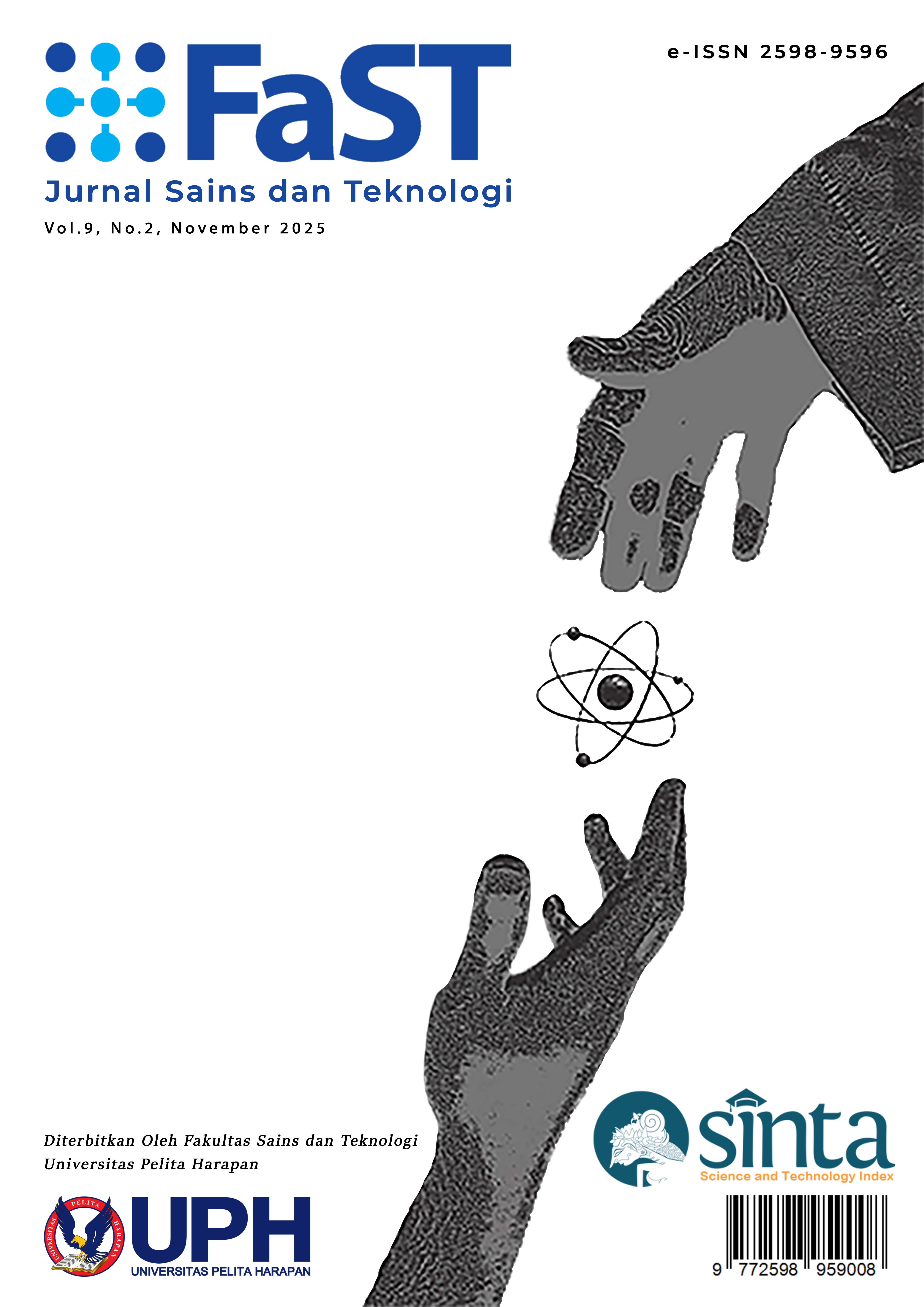Rancang Bangun Prototipe Sistem Keamanan Rumah Berbasis Internet Of Things (IoT) dengan Integrasi Sensor Pintar
[Design and Construction of an Internet of Things (IoT)-Based Home Security System Prototype with Smart Sensor Integration]
DOI:
https://doi.org/10.19166/jstfast.v9i2.9461Keywords:
ESP32-WROVER-CAM, Door Lock Solenoid, RFID, OV2640 Camera, TelegramAbstract
In this study, the author designed an internet-connected security system that allows homeowners to easily and efficiently control and monitor the system. The microcontroller used in this study, the ESP32-WROVER-CAM module, also requires several sensors: a PIR sensor, an RFID sensor, a touch sensor, a reed switch, a buzzer, a relay module, a camera sensor, and a door lock solenoid. This research resulted in a home security system that can be controlled in two ways: using RFID sensor readings and using the Telegram app. Using the Telegram app, the system responds and executes the command. Using an RFID card by attaching the card to the reader, if the card is detected correctly, all sensors will detect no suspicious activity. If someone opens the door by breaking in, the buzzer will sound, activating all sensors to notify the door has been forced open by an unknown person.
Bahasa Indonesia Abstract: Pada penelitian ini penulis merancang sebuah sistem keamanan yang terkoneksi dengan internet sehingga pemilik rumah dengan mudah dapat mengontrol dan memonitoring dengan mudah dan efisien. Mikrokontroller yang digunakan pada penelitian ini yakni Modul ESP32-WROVER CAM, juga memerlukan beberapa sensor yaitu sensor PIR, sensor RFID, sensor sentuh, reed switch, buzzer, modul relay, sensor kamera dan selenoid door lock. Penelitian ini menghasilkan sebuah sistem keamanan rumah yang dapat dikontrol menggunakan 2 cara yaitu menggunakan pembacaan dari sensor RFID dan juga bisa menggunakan aplikasi telegram, jika menggunakan aplikasi telegram dengan memberikan perintah ke sistem, sistem akan merespon dan langsung mengeksekusi perintah. Jika menggunakan kartu RFID dengan cara menempelkan kartu ke reader, apabila kartu yang terdeteksi benar maka seluruh sensor tidak akan mendeteksi hal-hal yang mencurigakan. Apabila seseorang membuka pintu dengan cara dibobol maka buzzer akan berbunyi, semua sensor aktif untuk memberikan notifikasi bahwa pintu telah dibuka secara paksa oleh orang yang tidak dikenali.
References
Afuw, R., Subyan, R., Hardi, N., & Arbasyah, A. (2023). Alat Berbasis IOT Smarthome Monitoring dan Kontrol via Telegram Menggunakan Nodemcu. 4(1), 7–11. https://doi.org/10.31294/instk.v4i1.2018
Bachri, A. (2018). Rancang Bangun Sistem Keamanan Sepeda Motor Dengan Fingerprint Berbasis Telephone. 3(2), 19.
ELKOMIKA: Jurnal Teknik Energi Elektrik, Teknik Telekomunikasi, & Teknik Elektronika, 6(1), 1. https://doi.org/10.26760/elkomika.v6i1.1
Emi, H. (2023). TTP-223 module. Espressif Systems. (2017). ESP32-WROVER Datasheet.
Handayani, T., Basuki, A., & Dirgantara, I. (2023). Rancang Bangun Sistem Keamanan Pintu Menggunakan Metode Pengenalan Wajah Berbasis Internet of Things. 5(1), 1–11. https://doi.org/10.28989/avitec.v5i1.1393
JTEIN: Jurnal Teknik Elektro Indonesia, 3(1), 136–146. https://doi.org/10.24036/jtein.v3i1.217
Julianthi, P., Husen, A., Tjahjono, G., & Tamal, C. P. (n.d.). Rancang Bangun Sistem Pengaman Sepeda Motor Dengan Menggunakan Sensor Sentuh TTP223. 6(2), 56–63.
Keamanan, S., & Berbasis, R. (2023). Sistem keamanan rumah berbasis esp32-cam dan telegram sebagai notifikasi. 8(1), 30–38. https://doi.org/10.32897/infotronik.2023.8.1.2291
Kurniawan, A. D. (2021). Design and Implementation of Home Security Using Telegram Botfather. 2(1), 11–15. https://doi.org/10.52005/fidelity.v2i1.105
Kurniawan, M. H., Siswanto, S., & Sutarti, S. (2019). Design and Build a Motorcycle Security System with Fingerprints and Telephone Call Notifications Based on Atmega 328. PROSISKO: Jurnal Pengembangan Riset dan Observasi Sistem Komputer, 6(2), 152–165.
Kurniawan, M. I., Sunarya, U., & Tulloh, R. (2018). Internet of Things : Sistem Keamanan Rumah berbasis Raspberry Pi dan Telegram Messenger. https://doi.org/10.26760/elkomika.v6i1.1
Magara, T. (2024). Internet of Things (IoT) of Smart Homes: Privacy and Security. Journal [online]. https://doi.org/10.1155/2024/7716956
Mandalawangi, A. R., & Habibullah, H. (2022). Rancang Bangun Sistem Pengendali CCTV Berbasis Node MCU Menggunakan Smartphone Android. https://doi.org/10.24036/jtein.v3i1.217
Mansyah, S., & Myori, D. E. (2022). Rancang Bangun Alarm Pintu Rumah Otomatis Menggunakan Sensor Magnet Bebasis Arduino Uno. 3(2), 407–415. https://doi.org/10.24036/jtein.v3i2.267
Monita, M., & Hendri, H. (2021). Sistem Kontrol Rumah Pintar Menggunakan Kamera Berbasis IoT. JTEIN: Jurnal Teknik Elektro Indonesia, 2(1), 107–112. https://doi.org/10.24036/jtein.v2i1.141
Parti, I. K., Mudiana, I. N., Darminta, I. K., Rasmini, N. W. (2024). Modellings Smart Home Security Based Internet of Things (IoT). Proceedings. https://doi.org/10.2991/978-94-6463-364-1_5
Pi, R., Pemantauan, S., Kaca, R., Pi, R., & Node-red, M. (2022). Greenhouse Monitoring System using ESP32 ,. 11(3), 133–138.
Prasad, A., Kapoor, P., Singh, T. P. (Eds.). (2022). Communication Technologies and Security Challenges in IoT. Springer.
Sabit, H. (2025). Artificial Intelligence-Based Smart Security System Using Internet of Things for Smart Home Applications. Electronics, 14(3), 608.
Sani, A., Julianto, R., Maulidiah, H. M., & Wimbang, J. (2023). Sistem Keamanan Pintar Menggunakan Kamera Berbasis OpenCV. 42–47. https://doi.org/10.30871/jaee.v7i1.5017
Sanjaya, D., & Jaya, P. (2023). Rancang Bangun Smart Locker Berbasis Internet Of Things P - ISSN : 2302-3295. 11(1). https://doi.org/10.24036/voteteknika.v11i1.121187
Sharma, S., Thirumalaisamy, M., Balusamy, B., Chilamkurti, N. (Eds.). (2024–2025). Artificial Intelligence and IoT for Cyber Security Solutions in Smart Cities. [Publisher]. https://doi.org/10.1201/9781003459835
Shull, H. (1977). The overhead headache. Science, 195(4279), 639. https://doi.org/10.1126/science.195.4279.639
Tappari, S. (2023). IoT Based Smart Home Automation and Security. LAP Lambert Academic Publishing. https://doi.org/10.22214/ijraset.2023.54204
Vardakis, G. (2024). Review of Smart-Home Security Using the Internet of Things. Electronics, 13(16), 3343. https://doi.org/10.3390/electronics13163343
Watmah, S., Kautsar, H. A. Al, & Suryanto, S. (2021). Perancangan Sistem Keamanan Brankas Menggunakan Metode Finger Print Berbasis SMS Gateway. INSANtek, 2(2), 35–39. https://doi.org/10.31294/instk.v2i2.907
You, L., Zhou, J., Li, Z., Chen, F. (2024). AI Ethics in Smart Homes: Progress, User Requirements and Challenges. arXiv preprint.
Downloads
Published
Issue
Section
License
Copyright (c) 2025 zainal abidin, Affan Bachri , Rizky Ananda Nugraha

This work is licensed under a Creative Commons Attribution-ShareAlike 4.0 International License.
“Authors who publish with this journal agree to the following terms:
1) Authors retain copyright and grant the journal right of first publication with the work simultaneously licensed under a Creative Commons Attribution License (CC-BY-SA 4.0) that allows others to share the work with an acknowledgement of the work's authorship and initial publication in this journal.
2) Authors are able to enter into separate, additional contractual arrangements for the non-exclusive distribution of the journal's published version of the work (e.g., post it to an institutional repository or publish it in a book), with an acknowledgement of its initial publication in this journal.
3) Authors are permitted and encouraged to post their work online (e.g., in institutional repositories or on their website). The final published PDF should be used and bibliographic details that credit the publication in this journal should be included.”



